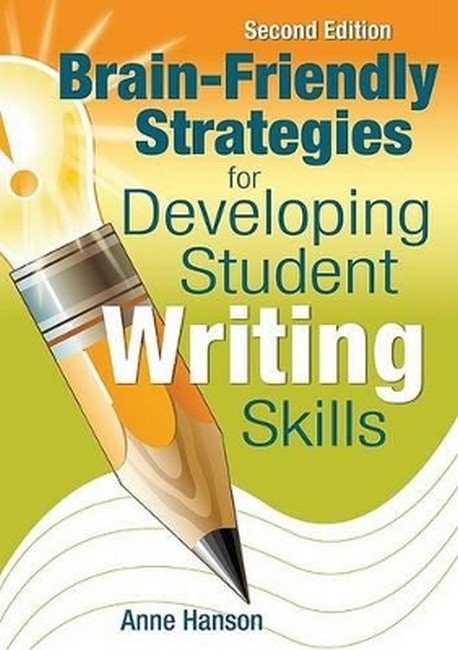Anne Hanson is a doctor of educational leadership whose research study dealt with the psychological syndrome of burnout in the No Child Left Behind high-stakes testing workplace. A National Board Certified language arts teacher with over 20 years classroom experience, Hanson has worked as a peer evaluator, staff developer, and literacy coach for teachers and students. Serving as the foundation for all her workshops is the research-based understanding of the emotional well-being necessary to succeed in the workplace, whether school or business. Hanson's career-long advocacy for teachers and students has influenced the design of her workshops, which are as diverse as her audiences, who range from administrators and teachers to parents and students from K-12 to the college level. Besides the first edition of Write Brain Write, Anne is the author of Visual Writing; "Writing" in The Praeger Handbook of Learning and the Brain; Wanted: Teachers for National Board Certification; and Thin Veils, a novel about deadly dieting. Hanson's awards and recognitions include Arizona Teacher of the Year finalist; Scottsdale Middle School Teacher of the Year; Japan Fulbright Memorial Fund scholar; New York Council for the Humanities scholar; and Arizona State University Martin Luther King, Jr. Spirit Award.
Request Academic Copy
Please copy the ISBN for submitting review copy form
Description
Acknowledgments About the Author Preface 1. Introducing the Brain-Compatible Framework for Student Achievement Four Brain-Compatible Classroom Principles Five Core Propositions of Accomplished Teaching Six Features of Effective Instruction The Brain-Compatible Framework for Student Achievement A Brain Journey Celebrating the Learning Brain 21st-Century Brain-Compatible Teachers 21st-Century High-Stakes-Tested Students Can You Hear Me Now? Questions for Reflection 2. Making Connections Across Instruction, Curriculum, and Life Characteristics of Feature One Reflecting on the Brain-Compatible Framework and Feature One The Brain-Compatible Framework With Feature One in Action Learning About Our Students Brain Surveys Writing Connections Writing: Pleasure or Pain? Seven Stages of Brain-Friendly Writing Instruction Verbs Are Your Friends: Describing Verbs How, Why, and What Verbs Questions for Reflection 3. Teaching Skills in Multiple Lesson Types Characteristics of Feature Two Separate, Simulated, and Integrated Instruction Reflecting on the Brain-Compatible Framework and Feature Two The Brain-Compatible Framework With Feature Two in Action Questions for Reflection 4. Integrating Test Preparation Into Instruction Characteristics of Feature Three?s Successful Teachers Reflecting on the Brain-Compatible Framework and Feature Three The Brain-Compatible Framework With Feature Three in Action Test Savvy Hero Quest Questions for Reflection 5. Teaching Students Strategies for Doing the Work Characteristics of Feature Four Reflecting on the Brain-Compatible Framework and Feature Four The Brain-Compatible Framework With Feature Four in Action The Clue to Exact Writing Setting the Stage for Authentic Assessment and Learning Questions for Reflection 6. Expecting Generative Thinking Characteristics of Feature Five Reflecting on the Brain-Compatible Framework and Feature Five The Brain-Compatible Framework and Feature Five in Action Generative Thinking in Elementary School Generative Thinking in Middle School Generative Thinking in High School Writing and Generative Thinking Questions for Reflection 7. Fostering Cognitive Collaboration Characteristics of Feature Six Reflecting on the Brain-Compatible Framework and Feature Six The Brain-Compatible Framework and Feature Six in Action Collaboration and Seating Arrangements Cognitive Collaboration Beyond the Classroom: Community Writing Partners Celebrate the Results Authors' Day Questions for Reflection 8. Envisioning Every Child as a Lifelong Learner References Index
"The major strengths of this book are the implications of current brain research and how to maximize student learning and enjoyment in the learning process. It's all about the learning in the classroom, which is where the focus must be." -- Mary Moore, Third-Grade Teacher "Provides teachers with applicable research on brain-compatible learning and provides students with tools for developing their talent as writers." -- Wanda Stuckey, English Teacher "Explains brain research in easy-to-understand language and includes real classroom stories from diverse grade levels and student populations, as well as cross-curricular writing activities that foster high literacy and performance on high-stakes tests. Any teacher who wants reliable research to support effective, brain-friendly instruction should read this book and share it with colleagues and administrators." -- Bobbie Faulkner, Teacher "Allows teachers to see the inside of a successful system for teaching students to write with confidence and proficiency. Hanson offers experience and personal learning on how the brain works and thinks about communication through writing." -- Patricia Allison, Recruitment, Retention, and Preparation Coordinator "Recognizes the importance of preparing teachers to act as involved researchers in their own classrooms. The book encourages teachers to develop practices that will help their students become lifelong learners, not just competent test takers." -- Edith Wagner, Associate Professor of English "Instructional leaders are constantly looking for ways to help teachers work smarter, not harder, in the quest to maximize student achievement. Hanson provides a brain-compatible framework to do precisely that." -- Shaun Holmes, Principal "A one-of-a-kind, practical text for all teachers. Hanson takes us on a journey by providing teaching strategies and specific examples to prepare students to become lifelong writers!" -- Sonia Aguila, ESL Teacher/Consultant "During the past thirty years as an English teacher and professor, as an educational publisher and national writing consultant, and as the director of the Educational Leadership Institute, I have not seen a more powerful book on the teaching of writing. Think of this book as a gift to yourself, your colleagues, and your students. Think of it as a spark that just might initiate a renaissance in the way writing is taught." -- RW (Skip) Kistner, President

